[English] 日本語
 Yorodumi
Yorodumi- PDB-6cil: PRE-REACTION COMPLEX, RAG1(E962Q)/2-INTACT/INTACT 12/23RSS COMPLE... -
+ Open data
Open data
- Basic information
Basic information
| Entry | Database: PDB / ID: 6cil | |||||||||
|---|---|---|---|---|---|---|---|---|---|---|
| Title | PRE-REACTION COMPLEX, RAG1(E962Q)/2-INTACT/INTACT 12/23RSS COMPLEX IN MN2+ | |||||||||
 Components Components |
| |||||||||
 Keywords Keywords | RECOMBINATION/DNA / VDJ recombination / RSS / RAG1/2 / RECOMBINATION / RECOMBINATION-DNA complex | |||||||||
| Function / homology |  Function and homology information Function and homology information: / regulation of tolerance induction / calcium-dependent protein kinase regulator activity / positive regulation of myeloid progenitor cell differentiation / regulation of T cell mediated immune response to tumor cell / positive regulation of mismatch repair / negative regulation of apoptotic cell clearance / plasmacytoid dendritic cell activation / negative regulation of RNA polymerase II transcription preinitiation complex assembly / myeloid dendritic cell activation ...: / regulation of tolerance induction / calcium-dependent protein kinase regulator activity / positive regulation of myeloid progenitor cell differentiation / regulation of T cell mediated immune response to tumor cell / positive regulation of mismatch repair / negative regulation of apoptotic cell clearance / plasmacytoid dendritic cell activation / negative regulation of RNA polymerase II transcription preinitiation complex assembly / myeloid dendritic cell activation / T-helper 1 cell activation / mature B cell differentiation involved in immune response / T-helper 1 cell differentiation / positive regulation of myeloid cell differentiation / positive regulation of toll-like receptor 2 signaling pathway / positive regulation of dendritic cell differentiation / C-X-C chemokine binding / negative regulation of CD4-positive, alpha-beta T cell differentiation / positive regulation of toll-like receptor 9 signaling pathway / B cell homeostatic proliferation / neutrophil clearance / negative regulation of T cell differentiation in thymus / positive regulation of glycogen catabolic process / DN2 thymocyte differentiation / pre-B cell allelic exclusion / DNA geometric change / positive regulation of toll-like receptor 4 signaling pathway / endothelial cell chemotaxis / RAGE receptor binding / positive regulation of organ growth / eye development / positive regulation of interleukin-1 production / Regulation of TLR by endogenous ligand / bubble DNA binding / regulation of behavioral fear response / V(D)J recombination / negative regulation of T cell apoptotic process / myeloid cell differentiation / alphav-beta3 integrin-HMGB1 complex / Apoptosis induced DNA fragmentation / myeloid progenitor cell differentiation / inflammatory response to antigenic stimulus / phosphatidylinositol-3,4-bisphosphate binding / macrophage activation involved in immune response / negative regulation of thymocyte apoptotic process / histone H3K4me3 reader activity / positive regulation of monocyte chemotaxis / MyD88 deficiency (TLR2/4) / regulation of nucleotide-excision repair / positive regulation of monocyte chemotactic protein-1 production / cellular response to interleukin-7 / endothelial cell proliferation / phosphatidylinositol-3,5-bisphosphate binding / positive regulation of chemokine (C-X-C motif) ligand 2 production / glycogen catabolic process / apoptotic cell clearance / supercoiled DNA binding / positive regulation of vascular endothelial cell proliferation / DNA binding, bending / IRAK4 deficiency (TLR2/4) / dendritic cell chemotaxis / regulation of T cell differentiation / MyD88:MAL(TIRAP) cascade initiated on plasma membrane / positive regulation of DNA binding / organ growth / positive regulation of T cell differentiation / T cell lineage commitment / positive regulation of wound healing / phosphatidylserine binding / B cell lineage commitment / positive regulation of sprouting angiogenesis / chemoattractant activity / endoplasmic reticulum-Golgi intermediate compartment / positive regulation of activated T cell proliferation / phosphatidylinositol-3,4,5-trisphosphate binding / TRAF6 mediated NF-kB activation / T cell homeostasis / negative regulation of type II interferon production / DNA topological change / positive regulation of interferon-alpha production / Advanced glycosylation endproduct receptor signaling / positive regulation of interleukin-10 production / negative regulation of blood vessel endothelial cell migration / T cell differentiation / protein kinase activator activity / positive regulation of blood vessel endothelial cell migration / Pyroptosis / protein autoubiquitination / four-way junction DNA binding / condensed chromosome / DNA polymerase binding / phosphatidylinositol-4,5-bisphosphate binding / transcription repressor complex / positive regulation of interleukin-12 production / positive regulation of autophagy / phosphatidylinositol binding / activation of innate immune response / lung development / positive regulation of interferon-beta production / response to glucocorticoid Similarity search - Function | |||||||||
| Biological species |   Homo sapiens (human) Homo sapiens (human) | |||||||||
| Method |  X-RAY DIFFRACTION / X-RAY DIFFRACTION /  SYNCHROTRON / SYNCHROTRON /  MOLECULAR REPLACEMENT / MOLECULAR REPLACEMENT /  molecular replacement / Resolution: 4.15 Å molecular replacement / Resolution: 4.15 Å | |||||||||
 Authors Authors | Chuenchor, W. / Chen, X. / Kim, M.S. / Gellert, M. / Yang, W. | |||||||||
| Funding support |  United States, 2items United States, 2items
| |||||||||
 Citation Citation |  Journal: Mol Cell / Year: 2018 Journal: Mol Cell / Year: 2018Title: Cracking the DNA Code for V(D)J Recombination. Authors: Min-Sung Kim / Watchalee Chuenchor / Xuemin Chen / Yanxiang Cui / Xing Zhang / Z Hong Zhou / Martin Gellert / Wei Yang /    Abstract: To initiate V(D)J recombination for generating the adaptive immune response of vertebrates, RAG1/2 recombinase cleaves DNA at a pair of recombination signal sequences, the 12- and 23-RSS. We have ...To initiate V(D)J recombination for generating the adaptive immune response of vertebrates, RAG1/2 recombinase cleaves DNA at a pair of recombination signal sequences, the 12- and 23-RSS. We have determined crystal and cryo-EM structures of RAG1/2 with DNA in the pre-reaction and hairpin-forming complexes up to 2.75 Å resolution. Both protein and DNA exhibit structural plasticity and undergo dramatic conformational changes. Coding-flank DNAs extensively rotate, shift, and deform for nicking and hairpin formation. Two intertwined RAG1 subunits crisscross four times between the asymmetric pair of severely bent 12/23-RSS DNAs. Location-sensitive bending of 60° and 150° in 12- and 23-RSS spacers, respectively, must occur for RAG1/2 to capture the nonamers and pair the heptamers for symmetric double-strand breakage. DNA pairing is thus sequence-context dependent and structure specific, which partly explains the "beyond 12/23" restriction. Finally, catalysis in crystallo reveals the process of DNA hairpin formation and its stabilization by interleaved base stacking. | |||||||||
| History |
|
- Structure visualization
Structure visualization
| Structure viewer | Molecule:  Molmil Molmil Jmol/JSmol Jmol/JSmol |
|---|
- Downloads & links
Downloads & links
- Download
Download
| PDBx/mmCIF format |  6cil.cif.gz 6cil.cif.gz | 486.5 KB | Display |  PDBx/mmCIF format PDBx/mmCIF format |
|---|---|---|---|---|
| PDB format |  pdb6cil.ent.gz pdb6cil.ent.gz | 375.4 KB | Display |  PDB format PDB format |
| PDBx/mmJSON format |  6cil.json.gz 6cil.json.gz | Tree view |  PDBx/mmJSON format PDBx/mmJSON format | |
| Others |  Other downloads Other downloads |
-Validation report
| Summary document |  6cil_validation.pdf.gz 6cil_validation.pdf.gz | 467.7 KB | Display |  wwPDB validaton report wwPDB validaton report |
|---|---|---|---|---|
| Full document |  6cil_full_validation.pdf.gz 6cil_full_validation.pdf.gz | 496.3 KB | Display | |
| Data in XML |  6cil_validation.xml.gz 6cil_validation.xml.gz | 40.6 KB | Display | |
| Data in CIF |  6cil_validation.cif.gz 6cil_validation.cif.gz | 63.4 KB | Display | |
| Arichive directory |  https://data.pdbj.org/pub/pdb/validation_reports/ci/6cil https://data.pdbj.org/pub/pdb/validation_reports/ci/6cil ftp://data.pdbj.org/pub/pdb/validation_reports/ci/6cil ftp://data.pdbj.org/pub/pdb/validation_reports/ci/6cil | HTTPS FTP |
-Related structure data
| Related structure data |  7470C  7480C 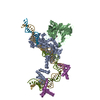 5zdzC 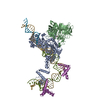 5ze0C  5ze1C  5ze2C 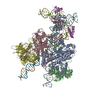 6cg0C  6cijC  6cikSC  6cimC S: Starting model for refinement C: citing same article ( |
|---|---|
| Similar structure data |
- Links
Links
- Assembly
Assembly
| Deposited unit | 
| ||||||||||||||||||||||||||||||||||||||||||||||||||||||||||||||||||||||||||||||||||||||||||||||||||||||||||||||
|---|---|---|---|---|---|---|---|---|---|---|---|---|---|---|---|---|---|---|---|---|---|---|---|---|---|---|---|---|---|---|---|---|---|---|---|---|---|---|---|---|---|---|---|---|---|---|---|---|---|---|---|---|---|---|---|---|---|---|---|---|---|---|---|---|---|---|---|---|---|---|---|---|---|---|---|---|---|---|---|---|---|---|---|---|---|---|---|---|---|---|---|---|---|---|---|---|---|---|---|---|---|---|---|---|---|---|---|---|---|---|---|
| 1 |
| ||||||||||||||||||||||||||||||||||||||||||||||||||||||||||||||||||||||||||||||||||||||||||||||||||||||||||||||
| Unit cell |
| ||||||||||||||||||||||||||||||||||||||||||||||||||||||||||||||||||||||||||||||||||||||||||||||||||||||||||||||
| Noncrystallographic symmetry (NCS) | NCS domain:
NCS domain segments:
|
 Movie
Movie Controller
Controller



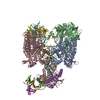
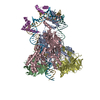







 PDBj
PDBj






















































